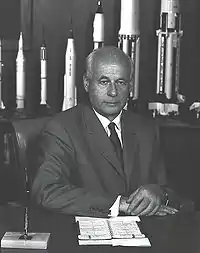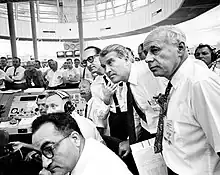Dr Eberhard Rees | |
|---|---|
 March 27, 1970 photo | |
| Born | April 28, 1908 |
| Died | April 2, 1998 (aged 89) |
| Nationality | German |
| Alma mater | University of Stuttgart Dresden Institute of Technology (1934) |
| Scientific career | |
| Fields | Aerospace engineering |
| Institutions | 1939-1945: HVP 1945-1960: ABMA 1960-1973: NASA |
| Notes | |
Fellow of the American Rocket Society (1959)[1] | |
Eberhard Friedrich Michael Rees (April 28, 1908 – April 2, 1998) was a German-American (by becoming a naturalized citizen of the United States) rocketry pioneer and the second director of NASA's Marshall Space Flight Center.[2]
Biography
Rees was born in Trossingen, Baden-Württemberg, Germany. After studying engineering at the University of Stuttgart, and graduating from the Dresden University of Technology in 1934 with his master's degree,[2] he worked his way to become the assistant manager of a steel mill in Leipzig, Germany.[3] Rees arrived at the Army Research Center Peenemünde in the spring of 1939[4] and managed V-2 rocket fabrication and assembly.[5] He served as Wernher von Braun's deputy from World War II through the Apollo program.[6]
Rees was in the first group of Operation Paperclip rocket scientists brought to the United States by the Army Ordnance Corps, arriving at Logan Field on October 2, 1945, and serving first at the Army Aberdeen Proving Grounds, then at Fort Bliss, in 1946[1] and in 1950, at the Redstone Arsenal. In August 1957, his team developed the ablative heat shield.[7]

After serving as Deputy Director of Development Operations for the Army Ballistic Missile Agency,[3] Rees became the Marshall Space Flight Center Deputy for Technical and Scientific Matters in 1960 and directed the Lunar Roving Vehicle program.[8]
On March 1, 1970, Rees was appointed as the Director of the Marshall Space Flight Center,[9] in Huntsville, Alabama, as von Braun's handpicked successor,[10] from which he managed the Skylab space station development and construction. He retired from NASA in 1973.[11]
On April 2, 1998, Rees died in a DeLand, Florida, hospital at the age of 89.[6]
References
- 1 2 Ordway, Frederick I. III; Sharpe, Mitchell R. (1979). The Rocket Team. Apogee Books Space Series 36. New York: Thomas Y. Crowell. pp. 288, 351–355, 391.
- 1 2 Burkhart, Ford (1998-04-04). "Eberhard Rees, Rocketry Pioneer, Dies at 89". The New York Times. Retrieved 2010-08-29.
- 1 2 "Dr. Eberhard Rees". MSFC Center Directors Biographical Sketches & Photo Gallery. Marshall Space Flight Center History Office. Archived from the original on 2006-09-30. Retrieved 2008-04-29.
- ↑ Braun, Wernher von; Ordway III, Frederick I. & David Dooling, Jr. (1985). Space Travel: A History. New York: Harper & Row. p. 170. ISBN 978-0-06-181898-1.
- ↑ "Rees, Eberhard F. M. (1909-1998)". Daviddarling.info. 2007-02-01. Retrieved 2010-08-29.
- 1 2 Burkey, Martin (1998-04-03). "Rees turned rocket visions into reality". The Huntsville Times.
Dr. Eberhard Rees, Wernher von Braun's deputy from World War II Germany to the manned lunar landings, died at 3:10 a.m. Thursday in a Florida hospital. He was 89. Rees's colleagues described him as the cautious, common-sense, day-to-day manager who turned the legendary rocket team leader's vision into reality. "He was the guy behind von Braun that made a lot of it happen," said J.R. Thompson, a longtime NASA official.
- ↑ York, New (1998-04-05). "Eberhard Rees - Chicago Tribune". Articles.chicagotribune.com. Retrieved 2010-08-29.
- ↑ Wright, Mike. "Eberhard Rees Was Marshall's Second Center Director". Management. Marshall Space Flight Center History Office. Archived from the original on 2008-05-11. Retrieved 2008-04-29.
With Skylab we are not concerned primarily with flying a spacecraft. We are concerned with the important aims of living and working in Earth orbit and conducting the experiments that will eventually lead to many beneficial results
- ↑ Storey, Angela D (1998-04-08). "Former Marshall Director Rees Dies" (PDF). Marshall Star. MSFC Public Affairs Office. Archived from the original (PDF) on 2005-11-13. Retrieved 2008-04-29.
- ↑ Swift, Earl (2021). Across the Airless Wilds: The Lunar Rover and the Triumph of the Final Moon Landings (First ed.). New York, NY: Custom House. p. 183. ISBN 978-0-06-298653-5.
- ↑ "Space Flight Center directors". The Huntsville Times. 2001-07-22. p. J23.